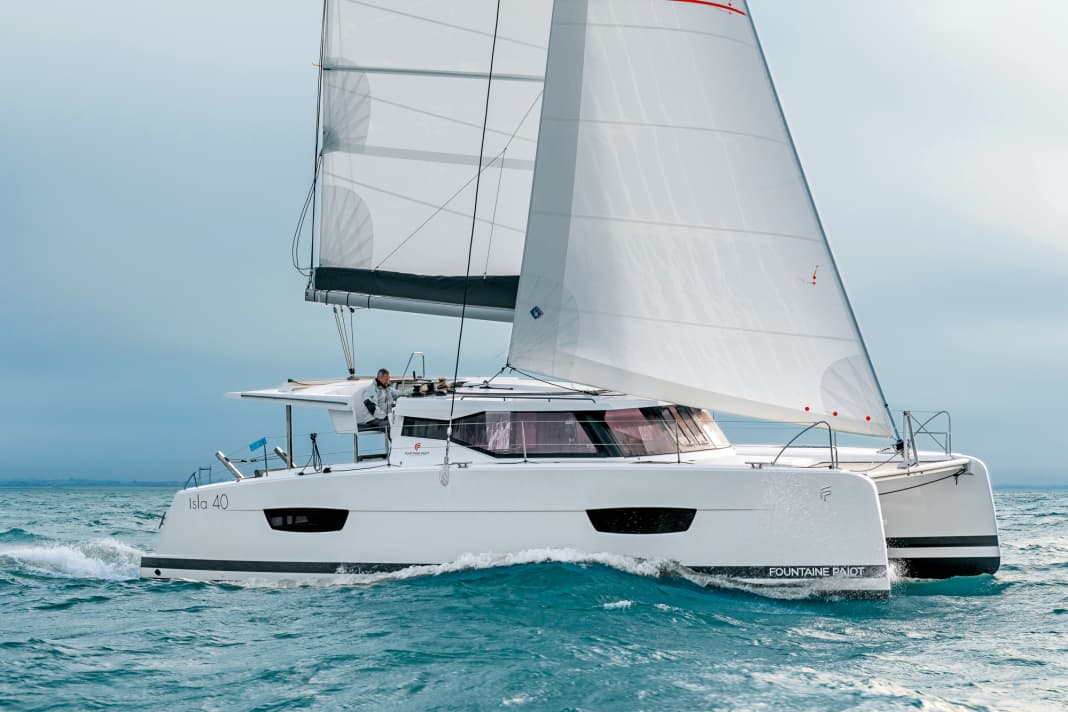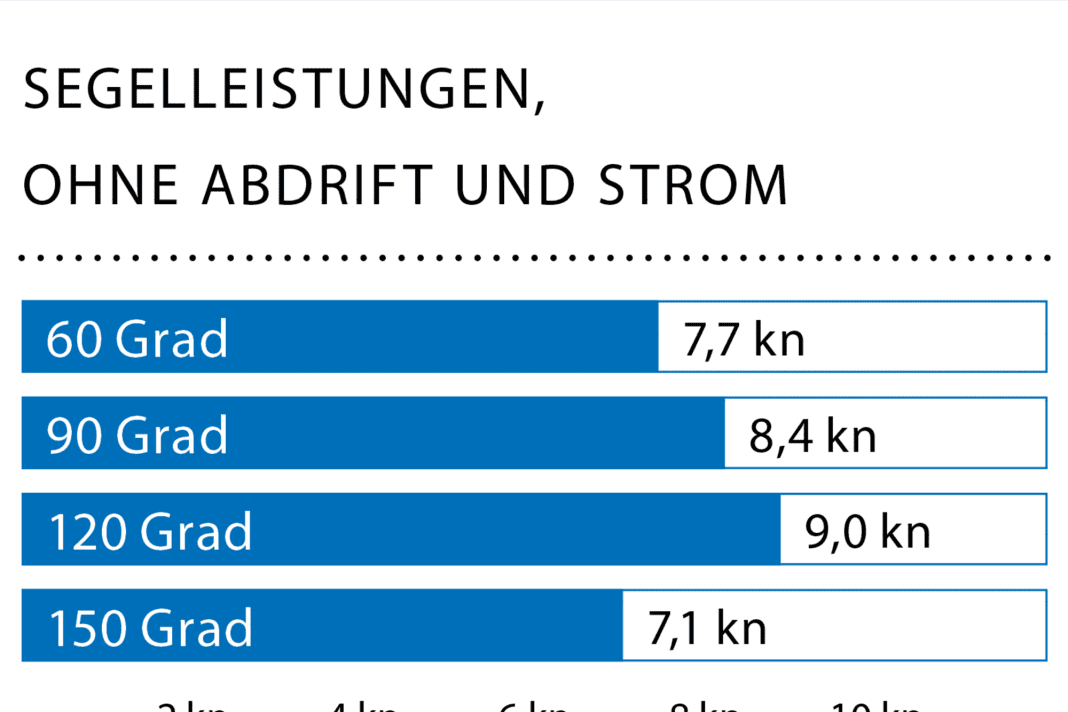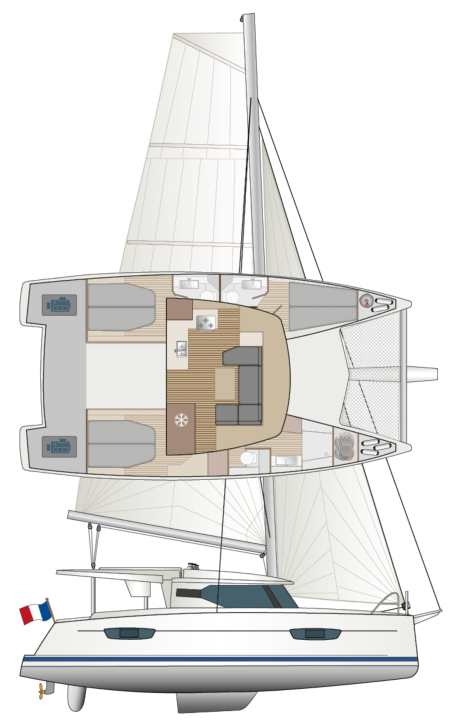





Through the centre
Success is one of those things. Of course, every shipyard wants brisk demand, happy customers, international boatbuilding prices and full order books. But what to do when things have been going well for years? How to develop, what to change - if at all?
Fountaine Pajot was faced with this dilemma. The company from La Rochelle is one of the most sought-after manufacturers of cruising catamarans - a global player and, with the takeover of Dufour, now also a permanent fixture in the monohull yacht market. The previous entry-level model, the Lucia 40, which was first launched eight years ago, has played a significant role in this. It has been built around 300 times and was once regarded as the best-selling multihull in the world in a segment that is not exactly lacking in competitors - popular with owners as well as in the charter market. It would probably still be today if Fountaine Pajot had not presented a successor in 2020.
It is called the Isla 40 and is almost as popular as the Lucia. In just over six months after its presentation, 110 orders had already been received for the popular twelve-metre catamaran - although it had not been seen at a single boat show until then due to the coronavirus.
Two test dates
What makes it so successful? To find out, we sailed it twice. Firstly in unusually mild autumn weather due to an intermediate high, which only offered 5 to 8 knots of wind and therefore did not allow any meaningful assessment of the sailing characteristics. The second outing on the Bay of Biscay took place under hazy grey skies, in wintry cold temperatures, but otherwise fine test conditions: 5 Beaufort with short, choppy seas.
The encounter felt familiar, and not just because of the repeat date. The Isla 40 is actually largely based on the Lucia. If you don't look closely, you might even think that the two are identical. But there are definitely differences, both stylistically and functionally. Although it is built from the same moulds as its predecessor, the Isla 40 has a slightly more dynamic, more elongated appearance. The negative deck step, the window front in the superstructure that tapers towards the stern, the almost floating appearance of the superstructure roof and the slightly inverted instead of straight sterns - even if these are just touch-ups, they are good for the design, which clearly bears the signature of the Astrea 44 and Elba 45.
Timeless and contemporary aesthetics
Designer Olivier Racoupeau explains the aim of the precision work: "When designing the exterior and interior, we developed a style that sets Fountaine Pajot apart and conveys the brand's core values: an aesthetic that is as timeless as it is contemporary." In fact, three or four strokes with an ink pen are enough to sketch the taut silhouette of the Isla and its sister models - an iconographic shape that radiates energy and conceals the enormous freeboard height of 1.88 metres surprisingly well.
The rig remained unchanged, which is a good thing. Although the trend in the cat market is towards masts positioned further aft, usually combined with a self-tacking jib, the shipyard has retained a slightly overlapping genoa. This is particularly advantageous in light and medium winds and slightly more open courses.
The higher unladen weight (Isla 9.5 tonnes, Lucia 8.9 tonnes) due to the more complex construction and additional reinforcements in the structure slightly reduces the sail carrying capacity. However, with a value of 4.6 (Lucia 4.7), the cat is still in the top third of the competition. And that's how it presents itself.
Fiercely contested 40-foot class: competition from the Fountaine Pajot Isla 40
Two temperaments
In the dying breeze of the first test trip, the worst possible test for touring cats with high weight and a lot of wetted surface, it was able to achieve a respectable 4 to 5 knots at the cross with an average wind of around 8 knots. The tacking angle then becomes quite wide; less than 110 to 120 degrees only leads to a drastic drop in speed to windward. But you can save yourself the use of the two Volvo Penta diesels, and the rather tight steering even retains an acceptable residual feel for the rudder. Nevertheless, there is no real sailing pleasure.
In contrast, the impressions from the second stroke with almost twice as much pressure in the air were significantly different. YACHT chief tester Michael Good not only noted values that were above the hull speed at half and peak room wind courses, but also an overall pleasing agility. "The Isla reacts well and quickly to the rudder," observed Good. Tacking is quick and easy; "there is no need to start up again". He also liked the relatively smooth movements of the hulls in short swell. The boat shows "comparatively little tendency to pitch", which is not a matter of course for a cat of moderate size.
The Isla can therefore make good progress in windier areas even without an additional sail. However, the Code Zero and gennaker can extend the range of action in light winds and on deep courses. They can be stowed perfectly in the forepeaks of both bows and set with little effort.
When designing the helm station, which also serves as an active cockpit for operating the sheets and outriggers, the shipyard used a familiar design. Everything is within easy reach on the slightly raised position to starboard, making one-handed operation possible. However, the concentration of lines, winches and stoppers requires a familiarisation phase.
Handling deficits
The genoa sheets cannot be disconnected, which somewhat restricts the other trimming options. For traveller and mainsheet, the distances between the stoppers and the winch are very tight. In addition, ropes can get caught behind the engine control levers during manoeuvres. And there is another annoying peculiarity: the panels for starting the diesel engines are located on the bulkhead, in front of the steering wheel. They cannot be reached safely when the autopilot is on course because you have to reach through the spokes with your fingers. So if you want to start the engines quickly, you should deactivate the autopilot beforehand.
On the other hand, the connection between the helm station and cockpit roof as well as to the guest cockpit is successful. Despite his slightly exposed position, the helmsman always remains in contact with the crew and also has a good overview of the boat and the surroundings. However, anyone interested in buying a boat should definitely order a small bimini with side tarpaulins for the helm cockpit, which are unfortunately not part of the standard equipment. Otherwise, rain will find its way into the guests' lounge area, and even into the saloon if the wind direction is unfavourable.
Genetic defects and evolutionary gain
And while we're at it: Why the shipyard still doesn't have the upholstery for the cockpit cut to fit the lids of the cockpit lockers below remains a mystery. The bench aft, in front of the dinghy davits, is the most troublesome. Two backrest cushions make it difficult to open the hatch in the centre - a genetic defect that has made it from the Lucia to the otherwise so harmoniously developed Isla 40.
The interior has been beautifully and sensibly refurnished and seamlessly connected to the cockpit via two sliding glass elements. The now rounded galley surfaces made of Corian are striking and have a style-defining effect. The seating area, which seats six people, now ends in a kind of chaise longue on the port side, where the Lucia still had a bare navigation corner. This not only looks casual; it is also a great place to sit and lie down.
Gain in living comfort
The expansion, which was not Fountaine Pajot's strongest point in the past, has made noticeable gains in recent years. This is also the case here. With the exception of a few details and a few gaps concealed with wide sealant joints, the workmanship and material feel correspond to good large series standards. The Isla 40 tested was not completely free of slight squeaking noises under load and at sea, but it was better than some of its competitors.
What also sets it apart is the sufficient to overwhelmingly large amount of usable storage space. In the three-compartment version that we tested, which is the most common, there is only a shortage of space in the foredeck of the port hull, even in terms of the berth area. Aft, however, there is already enough space, and the owner's hull to starboard offers truly lavish dimensions: almost 12 square metres of space in total, no less than 2.5 cubic metres (!) of storage volume in drawers, lockers and cupboards as well as a virtually sprawling wet room with - of course - a separate shower. Only multihulls offer this.
The headroom is essentially between 1.88 and 2.05 metres, which is sufficient for the size of the ship. However, there is a lack of width in the two companionways to the hulls, and the passage to the foredeck is almost claustrophobically narrow at 41 centimetres in the door frame, especially as the doors further restrict the room for manoeuvre in the cabin. Other cats in the same class are now more airy in design.
Bestseller 2.0
The Isla 40 may not be at the top everywhere, but it is not noticeably behind anywhere. Rather, in an increasingly differentiated market, it hits the middle ground surprisingly well, making it the ideal cruising cat for many: with very decent sailing characteristics, enough space and comfort, unmistakable lines and at an adequate price.
It has no shortage of established competition. The Leopard 40 built in South Africa is the most directly comparable, while the Lagoon 40 and the new Bali Catspace may have an even better space concept, and a Nautitech 40 and the Excess 11 a somewhat sportier design. However, as the one cat for all, the Isla is unquestionably a force to be reckoned with - and therefore a worthy successor to the Lucia.
The measured values for testing the Fountaine Pajot Isla 40




The Fountaine Pajot Isla 40 in detail

Technical data of the Fountaine Pajot Isla 40
- Design engineer: Berret/Racoupeau
- CE design category: A
- Torso length: 11,93 m
- Width: 6,63 m
- Depth: 1,21 m
- Weight: 9,5 t
- Mainsail: 59,0 m2
- Genoa (105 %): 36,0 m2
- machines (Volvo Penta): 2 × 20 HP
- Tanks (diesel/water): 300/530 l
Hull and deck construction
GRP sandwich laminate with balsa wood core. Hull: Vacuum infusion process. Deck: Vacuum injection
Price and shipyard
- Price ex shipyard: 511,700 € gross
- Warranty general/hull: 2/5 years
Status 02/2024
Shipyard
Fountaine Pajot, 17290 Aigrefeuille/France; www.fountaine-pajot.com
YACHT review of the Fountaine Pajot Isla 40
With the Isla 40, Fountaine Pajot continues the success of the bestseller Lucia. Not much has changed, apart from a few stylistic refinements. That fits! The cruising cat covers a broad spectrum well
Design and concept
- + Compact boat, popular size
- + High level of customisability
Sailing performance and trim
- + Good sailing characteristics
- + Sufficient feedback on the wheel
- - Operation takes some getting used to
Living and finishing quality
- + Contemporary, practical layout
- - Tight foredeck compartment
- - Squeaking noises in rough seas
Equipment and technology
- + Lots of storage space
- + Plenty of space and sunbathing areas on deck
- + Clean motor installations
The article first appeared in YACHT 09/2021 and has been updated for this online version.

